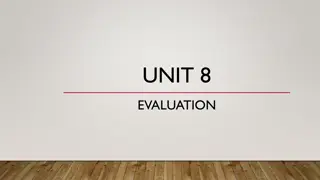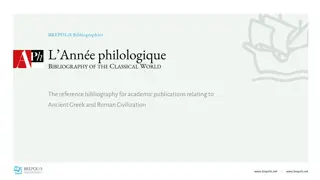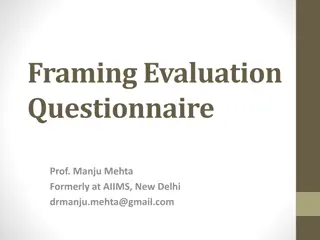Guide to Annotated Bibliography: Sources, Evaluation, and Guidelines
Understand the importance of an annotated bibliography, which includes a list of sources with personal commentary. Learn how to summarize, evaluate, and critique sources for academic research. Follow the guidelines to create entries formatted in MLA style and use appropriate sources for your paper.
Uploaded on Sep 11, 2024 | 0 Views
Download Presentation

Please find below an Image/Link to download the presentation.
The content on the website is provided AS IS for your information and personal use only. It may not be sold, licensed, or shared on other websites without obtaining consent from the author. Download presentation by click this link. If you encounter any issues during the download, it is possible that the publisher has removed the file from their server.
E N D
Presentation Transcript
Annotated Bibliography Guidelines Find and read sources Evaluate sources
A Bibliography is . . . A list of books A list of sources on a particular subject A list of the sources you used to write a paper
An Annotation is . . . Summary Explanation Evaluation/Criticism
Annotated Bibliography = A list of sources (books, articles, web pages, etc.) on your topic, with commentary on each source written by you. This commentary might summarize what the source is about, how it relates to your topic, which parts are particularly relevant, why the author is believable, and whether or not you agree with the information presented.
Annotated Bibliography Your entries will look like this: Author name. Title of Source. Publication information. (MLA Citation of Source) Underneath each source you will be including a paragraph summarizing the source. The more detailed this paragraph, the better and a critique paragraph evaluating the source. The slides that follow in these lecture notes describe the guidelines for finding the sources and writing the notes. It is especially important to use appropriate sources when doing academic research. All sources will be formatted MLA style.
Purpose The purpose of an annotated bibliography is to help you keep a running log of the research you have done and be able to quickly look back at its contents and their usefulness.
Purpose An annotated bibliography also provides a starting point when researching a topic you want to discover more about.
Starting the process Your Annotated Bibliography is the starting point for your research. As you look for information, make a list of the sources you find and evaluate each one.
Annotated Bibliography You should begin exploring in search of sources for your Annotated Bibliography / paper. You should begin collecting sources and taking notes. You will need to find the number of sources your teacher identifies for your Annotated Bibliography.
Jot it down! The following guidelines are good to follow for any research process: As you explore sources, make certain to write down the following information about any sources you are considering
Jot it down! Author s name, title, and credentials Title of the article Publication information, including: name of database newspaper/ magazine/ journal/ encyclopedia/ anthology name Volume numbers city of publication, publisher organization connected to the source date of publication, date viewed by student, page numbers, website address
Jot it down! Example source on 38 Who saw Murder Author s name, title, and credentials Jim Rasenberger author & journalist for The New York Times Title of the article: Nightmare on Austin Street. Publication information American Heritage 57.5 (2006): 65-66 TCC database: Academic Search Complete. EBSCO
Plug information in to MLA format Here is the source in MLA format: Rasenberger, Jim. Nightmare on Austin Street. American Heritage. 57.5 (2006): 65-66. Academic Search Complete. EBSCO. TCC Library, Portsmouth, VA. 12 Nov. 2008. <http://search.ebscohost.com>.
The Summary Write 4 6 complete sentences that accomplish all/most of the following:
The Summary Provide the background and credibility of the author State the main focus or purpose of the work. Briefly describe the contents. Indicate the possible audience for the work.
The Evaluation Write 2-4 complete sentences that accomplish all/most of the following:
The Evaluation Describe any special features of the work that were unique or helpful ( Aims & Research Methods). Point to any defect, weakness, or suspected bias. (fallacies or limitations) Mention important conclusions or observations reached by the author Evaluate the usefulness or relevance to your research topic(Reflection/Usefulness to your research or topic Will you use this source? And/or why it did not meet your expectations.., How will the source support your narrowed down focus?)
The Annotation A sample: Jim Rasenberger, an author and journalist for the New York Times, asserts that the events as described by Gansberg in 38 Who Saw Murder could not have happened the way Gansberg described them. Rasenberger states that although 38 people may have heard or seen the initial attack, Genovese was attacked three times. The most serious attack occurred in the back foyer of her apartment building, and could have been witnessed by five or six people at most. He concludes his article by saying that if Gansberg s account had been accurate, countless articles and books would never have been written about the incident and Americans apathy would not have been studied as thoroughly. He seems pleased that the initial and most famous account was flawed. Rasenberger s article is interesting, but contains few facts and little research to support his assertions. The article is helpful as a starting point for a critical view of Gansberg s article.
On the next slide, you will see the same paragraphs color-coded by specific criteria Background & credibility of author Possible Audience Main idea Contents Usefulness to my topic/research
The Annotation Jim Rasenberger, an author and journalist for the New York Times, asserts that the events as described by Gansberg in 38 Who Saw Murder could not have happened the way Gansberg described them.Rasenberger s assumes his audience is familiar with Gansberg s famous and widely published article. Rasenberger states that although 38 people may have heard or seen the initial attack, Genovese was attacked three times. The most serious attack occurred in the back foyer of her apartment building, and could have been witnessed by five or six people at most. He concludes his article by saying that if Gansberg s account had been accurate, countless articles and books would never have been written about the incident and Americans apathy would not have been studied as thoroughly. He seems pleased that the initial and most famous account was flawed. Rasenberger s article is interesting, but contains few facts and little research to support his assertions. The article is helpful as a starting point for a critical view of Gansberg s account of events. Background & credibility of author Possible Audience Main idea Contents Usefulness to my topic/research
Completed Example Annotated Bibliography entry Rasenberger, Jim. Nightmare on Austin Street. American Heritage. 57.5 (2006): 65-66. Academic Search Complete. EBSCO. TCC Library, Portsmouth, VA. 12 Nov. 2008. <http://search.ebscohost.com>. Jim Rasenberger, an author and journalist for the New York Times, asserts that the events as described by Gansberg in 38 Who Saw Murder could not have happened the way Gansberg described them. Rasenberger states that although 38 people may have heard or seen the initial attack, Genovese was attacked three times. The most serious attack occurred in the back foyer of her apartment building, and could have been witnessed by five or six people at most. He concludes his article by saying that if Gansberg s account had been accurate, countless articles and books would never have been written about the incident and Americans apathy would not have been studied as thoroughly. He seems pleased that the initial and most famous account was flawed. Rasenberger s article is interesting, but contains few facts and little research to support his assertions. The article is helpful as a starting point for a critical view of Gansberg s article.
Sources Where can college students find reliable, scholarly sources?
Old habits Many students do research by using a general search engine such as Google. This type of search is a habit that does not work well when doing college research.
Why not Google or Wikipedia? On the Internet . No selection process: Documents do not undergo any selection process but rather are placed there at will by anyone with access to a web server.
Why not Google or Wikipedia? No standards: There is no overall effort, nor any rules or standards, to organize information to facilitate retrieval. Often, commercial sites or sites soliciting donations dominate search results.
Why not Google or Wikipedia? No validation: No one reviews sites for accuracy. The internet is filled with hoaxes, scams, parodies, and hate speech disguised as fact.























